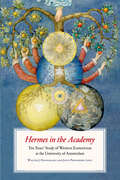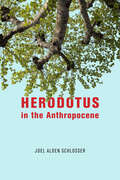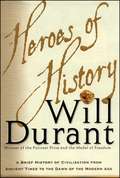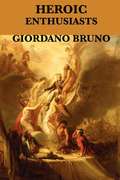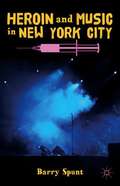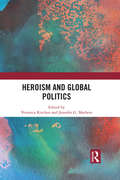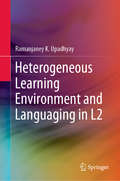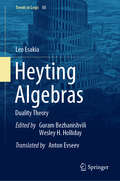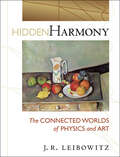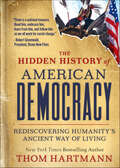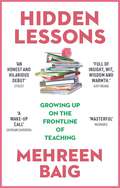- Table View
- List View
Hermes II: Interference (Posthumanities #73)
by Michel SerresUnveiling the hidden connections in the network of knowledgeHermes II: Interference is the second in a series of works by philosopher Michel Serres using Hermes, god of communication, as an archetypal symbolic figure for reflecting on philosophy and the arts and sciences. Serres delves into the concept of interreferentiality, proposing that every node—whether it be knowledge, objects, or people—exists within a network where it both receives and transmits information. He argues against the existence of a dominant center or pole within these networks, emphasizing that each node can temporarily serve as a focal point depending on context. Serres presents unique insights into topics such as the nature of knowledge, the world of objects, intersubjectivity, the origins of geometry, the interplay of music and background noise, and empiricism. By identifying parallel structures across these areas, Serres unifies them into a comprehensive theoretical framework, revealing hidden connections and potential future influences. Additionally, this work includes a critique of Gaston Bachelard&’s The Formation of the Scientific Mind and concludes with an analysis of communication in Hergé&’s The Castafiore Emerald. Hermes II is a unique blend of ancient and modern perspectives, combining rigorous analysis with an optimistic outlook and highlighting the interconnectedness of knowledge and its implications for fostering peaceful relations within the network of life.
Hermes in the Academy: Ten Years' Study of Western Esotericism at the University of Amsterdam
by Wouter J. Hanegraaff Joyce PijnenburgHermes in the Academy commemorates the tenth anniversary of the Center for History of Hermetic Philosophy and Related Currents (GHF) at the University of Amsterdam. The center devotes itself to the study of Western esotericism, which includes topics such as Hermetic philosophy, Christian kabbalah and occultism.This volume shows how, over the past ten years, the GHF has developed into the leading international center for research and teaching in this domain.
Hermit: A memoir of finding freedom in a wild place
by Jade Angeles Fitton'I never imagined that the wind would blow me here, to a kind of isolation I have never experienced... There is never anything out here but my shadow, that no one treads on any more'When Jade's partner leaves the barn that they moved into just weeks before, he leaves a dent in the wall and her life unravelled. Numbed from years in a destructive, abusive relationship, she faces an uncertain future and complete solitude. Slowly, with the help of Devon's salted cliffs and damp forested footpaths, Jade comes back to life and discovers the power of being alone.As Jade reacclimatizes, she considers what it means to live alone. Through conversations with other hermits across the world, Fitton sheds light on the myriad - and often misunderstood - ways of living alone: from monks to hikikomori, and the largely ignored female hermit. Jade questions whether hermitic living is possible in an era of constant communication and increased housing costs as she finds herself financially unstable and itinerant. She realises that home doesn't exist within walls, but within the landscape of her childhood home county.Lyrically written, this is an inspirational story of recovery, of finding home, and of celebrating solitude in the natural world.
Herodotus in the Anthropocene
by Joel Alden SchlosserWe are living in the age of the Anthropocene, in which human activities are recognized for effecting potentially catastrophic environmental change. In this book, Joel Alden Schlosser argues that our current state of affairs calls for a creative political response, and he finds inspiration in an unexpected source: the ancient writings of the Greek historian Herodotus. Focusing on the Histories, written in the fifth century BCE, Schlosser identifies a cluster of concepts that allow us to better grasp the dynamic complexity of a world in flux. Schlosser shows that the Histories, which chronicle the interactions among the Greek city-states and their neighbors that culminated in the Persian Wars, illuminate a telling paradox: at those times when humans appear capable of exerting more influence than ever before, they must also assert collective agency to avoid their own downfall. Here, success depends on nomoi, or the culture, customs, and laws that organize human communities and make them adaptable through cooperation. Nomoi arise through sustained contact between humans and their surroundings and function best when practiced willingly and with the support of strong commitments to the equality of all participants. Thus, nomoi are the very substance of political agency and, ultimately, the key to freedom and ecological survival because they guide communities to work together to respond to challenges. An ingenious contribution to political theory, political philosophy, and ecology, Herodotus in the Anthropocene reminds us that the best perspective on the present can often be gained through the lens of the past.
Heroes
by Franco Bifo" BerardiWhat is the relationship between capitalism and mental health? In his most unsettling book to date, Franco "Bifo" Berardi embarks on an exhilarating journey through philosophy, psychoanalysis and current events, searching for the social roots of the mental malaise of our age. Spanning an array of horrors - the Aurora "Joker" killer; Anders Breivik; American school massacres; the suicide epidemic in Korea and Japan; and the recent spate of "austerity" suicides in Europe - Heroes dares to explore the darkest shadow cast by the contemporary obsession with relentless competition and hyper-connectivity. In a volume that crowns four decades of radical intellectual work, Berardi develops the psychoanalytical insights of his friend Félix Guattari and proposes dystopian irony as a strategy to disentangle ourselves from the deadly embrace of absolute capitalism.From the Trade Paperback edition.
Heroes
by Paul JohnsonA galaxy of legendary figures from the annals of Western history In this enlightening and entertaining work, Paul Johnson, the bestselling author of Intellectuals and Creators, approaches the subject of heroism with stirring examples of men and women from every age, walk of life, and corner of the planet who have inspired and transformed not only their own cultures but the entire world as well. Heroes includes: Samson, Judith, and Deborah Henry V and Joan of Arc Elizabeth I and Walter Raleigh George Washington, the Duke of Wellington, and Lord Nelson Emily Dickinson Abraham Lincoln and Robert E. Lee Mae West and Marilyn Monroe Ronald Reagan, Margaret Thatcher, and Pope John Paul II
Heroes and Philosophy: Buy the Book, Save the World (The Blackwell Philosophy and Pop Culture Series #4)
by William IrwinThe first unauthorized look at the philosophy behind Heroes, one of TV's most popular shows When ordinary individuals from around the world inexplicably develop superhuman abilities, they question who they are, struggle to cope with new responsibilities, and decide whether to use their new power for good or for evil. Every episode of Tim Kring's hit TV show Heroes is a philosophical quandary. Heroes and Philosophy is the first book to analyze how philosophy makes this show so compelling. It lets you examine questions crucial to our existence as thinking, rational beings. Is the Company evil, or good? Does Hiro really have a destiny? Do we? Is it okay to lie in order to hide your powers or save the world? Heroes and Philosophy offers answers to these and other intriguing questions. Brings the insight of history's philosophical heavyweights such as Plato and Nietzche to Heroes characters and settings Adds a fun and fascinating dimension to your understanding of the show Expands your thinking about Heroes as the series expands from graphic and text novels to action figures and a video game Whether you're new to Heroes or have been a fan since day one, this book will take your enjoyment of the show to the next level.
Heroes of History
by Will DurantIn the tradition of his own bestselling masterpieces The Story of Civilization and The Lessons of History, Pulitzer Prize-winning historian Will Durant here traces the lives and ideas of those who have helped to define civilization, from its dawn to the beginning of the modern world. Four years before his death, Will Durant began work on an abbreviated version of his highly acclaimed eleven-volume series, The Story of Civilization. The project was conceived as a series of audio lectures, but Durant soon realized that the dialogues could be developed into a book that would serve as a wonderfully readable introduction to the subject of history. Durant completed twenty-one of a proposed twenty-three chapters before his death in 1981, at the age of ninety-six. Those chapters span thousands of years of human history -- from Confucius to Shakespeare, from the Roman Empire to the Reformation, finally ending in the eighteenth century. The manuscript was recently found by Will Durant scholar John Little -- twenty years after Durant finished it -- and its discovery is a major event, not only for lovers of his prose, but for students of history and philosophy the world over. Heroes of History is a book of life-enhancing wisdom and optimism, complete with Durant's wit, knowledge, and unique ability to explain events and ideas in simple, exciting terms. It is the lessons of our heritage passed on for the edification and benefit of future generations -- a fitting legacy from America's most beloved historian and philosopher. Will Durant's popularity as America's favorite teacher of history and philosophy remains undiminished by time. His books are accessible to readers of every kind, and his unique ability to compress complicated ideas and events into a few pages without ever "talking down" to the reader, enhanced by his memorable wit and a razor-sharp judgment about men and their motives, made all of his books huge bestsellers. Heroes of History carries on this tradition of making scholarship and philosophy understandable to the general reader, and making them good reading, as well. At the dawn of a new millennium and the beginning of a new century, nothing could be more appropriate than this brilliant book that examines the meaning of human civilization and history and draws from the experience of the past the lessons we need to know to put the future into context and live in confidence, rather than fear and ignorance. Will Durant's work is marked by his own special quality as a writer -- he is tough-minded, optimistic, courageous, and convinced that without a knowledge of the past there is no wisdom to guide us to the future. Heroes of History was his last word on the subject, and much of it has been aimed directly at the doubts and fears of people today. It is a major, and unexpected, literary and historical event. This book is also available on audio tape and CD format, read by Will and Ariel Durant. If you would like more information on this and other products featuring Will Durant's life-enhancing philosophy, we encourage you to visit the web site at www.willdurant.com.
Heroic Enthusiasts
by Giordano BrunoThe Heroic Enthusiasts is a deeply allegorical dialogue by Giordano Bruno. It is a philosophical discussion of love and the nature of God and Man. This great work is reminiscent of Shakespeare.
Heroin and Music in New York City
by Barry SpuntUsing narrative accounts from a sample of 69 New York City-based musicians of various genres who are self-acknowledged heroin users, the book addresses the reasons why these musicians started using heroin and the impact heroin had on these musicians' playing, creativity, and careers.
Heroism and Global Politics
by Veronica Kitchen Jennifer G. MathersThe rhetoric of heroism pervades politics. Political leaders invoke their own heroic credentials, soldiers are celebrated at sporting events, ordinary citizens become state symbols (or symbols of opposition), and high profile celebrities embody a glamorized, humanitarian heroism. Using analytical tools drawn from international relations, gender studies, war studies, history, and comparative politics, this book examines the cultural and political phenomenon of heroism and its relationship to the process of creating, sustaining and challenging political communities. Arguing that heroism is socially constructed and relational, the contributors demonstrate that heroes and heroic narratives always serve particular interests in the ways that they create and uphold certain images of states and other political communities. Studying the heroes that have been sanctioned by a community tells us important things about that community, including how it sees itself, its values and its pressing needs at a particular moment. Conversely, understanding those who are presented in opposition to heroes (victims, demonized opponents), or who become the heroes of resistance movements, can also tell us a great deal about the politics of a state or a regime. Heroes are at once the institutionalization of political power, and yet amorphous--one can go from being a hero to a villain in short order. This book will appeal to scholars and students working on topics related to international relations, gender, security and war studies, comparative politics, state building, and political communities.
Heroism and the Changing Character of War
by Sibylle ScheipersPost-heroism is often perceived as one of the main aspects of change in the character of war, a phenomenon prevalent in western societies. According to this view, demographic and cultural changes in the west have severely decreased the tolerance for casualties in war. This edited volume provides a critical examination of this idea.
Heterogeneous Learning Environment and Languaging in L2 (Springerbriefs In Education Ser.)
by Ramanjaney K. UpadhyayThis book explores heterogeneity in the Indian academic setting. Presenting a study on the performance of Bachelor of Engineering students from various parts of the county, it analyzes the subjects’ language skills on the basis of selected sociolinguistic variables and examines the possible role/impact of using multiple languages in the communicative setting described. In turn, the book investigates the differences between the way language is viewed in the Orient and in the Western world, and how, despite their differences, these views lead to similar language teaching methods in both worlds. It also highlights the limitations of current theories and frameworks in terms of accommodating modern methods of assessing language skills. Addressing socio-pragmatic issues in terms of English proficiency and language assessment, it is the first book to offer such a focused and detailed discussion of these varied but related issues, making it a valuable resource for all scholars and researchers working in the areas of socio-pragmatics, language assessment, and intercultural communication.
Heterotopia and Heritage Preservation: The Heterotopic Tool as a Means of Heritage Assessment (The Urban Book Series)
by Smaranda SpanuThis book approaches the field of built heritage and its practices by employing the concept of heterotopia, established by the French philosopher Michel Foucault. The fundamental understandings of heritage, its evolution and practices all reveal intrinsic heterotopic features (the mirror function, its utopic drive, and its enclave-like nature). The book draws on previous interpretations of heterotopia and argues for a reading of heritage as heterotopia, considering various heritage mechanisms – heritage selection, conservation and protection practices, and heritage as mnemonic device – in this regard. Reworking the six heterotopic principles, an analysis grid is designed and applied to various built heritage spaces (vernacular, religious architecture, urban 19th century ensembles). Guided through this theoretical itinerary, the reader will rediscover the heterotopic lens as a minor, yet promising, Foucauldian device that allows for a better understanding of heritage and its everyday practices.
Heuristic Reasoning
by Emiliano IppolitiHow can we advance knowledge? Which methods do we need in order to make new discoveries? How can we rationally evaluate, reconstruct and offer discoveries as a means of improving the 'method' of discovery itself? And how can we use findings about scientific discovery to boost funding policies, thus fostering a deeper impact of scientific discovery itself? The respective chapters in this book provide readers with answers to these questions. They focus on a set of issues that are essential to the development of types of reasoning for advancing knowledge, such as models for both revolutionary findings and paradigm shifts; ways of rationally addressing scientific disagreement, e. g. when a revolutionary discovery sparks considerable disagreement inside the scientific community; frameworks for both discovery and inference methods; and heuristics for economics and the social sciences.
Heuristic Rhetoric: Principles and Practice (Rhetoric, Politics and Society)
by Gábor TahinThis book introduces a novel approach to the analysis and practice of persuasive speaking and writing: heuristic rhetoric. The new method has evolved to fulfil the need at universities, government departments, political organisations, business enterprises and other public institutions for a modern practical alternative to classical rhetoric, which is, in the author’s view, no longer capable of giving a complete description of contemporary, predominantly mediatised, forms of public persuasive discourse, whilst other competing disciplines, such as critical discourse analysis or strategic manoeuvring, have not yet produced a set of tools, which have the comprehensive nature and practical orientation of Classical Greek and Roman rhetorical system. The book expounds heuristic rhetoric as an inter-disciplinary method to develop advanced skills of critical and strategic reasoning. Applying a novel set of principles for the strategic analysis of persuasive reasoning in complex rhetorical situations, the method emphasizes preparing and continuously adjusting argumentation according to the demands of unpredictable circumstances.
Heydar Aliyev and the Foundations of Modern Azerbaijan
by Michael M. Gunter M. Hakan Yavuz Shamkhal AbilovThis edited book examines and analyses Heydar Aliyev, the architect and founder of modern, post-Soviet Azerbaijan. The editors of the volume discuss developments between 1993 and 2003 – a decade that saw the establishment of the institutional foundations of the current republic, the adoption of a new form of national identity, the redefinition of the concept of the Azerbaijani state, and the creation of a security establishment designed to gain control of territories Armenia had held since the 1988-1994 war over Karabakh. The book explains why this fateful period had far-reaching consequences for Azerbaijan as a fully formed state and society, as well as major implications for its political future and its geopolitical strategy.
Heyting Algebras: Duality Theory (Trends in Logic #50)
by Leo EsakiaThis book presents an English translation of a classic Russian text on duality theoryfor Heyting algebras. Written by Georgian mathematician Leo Esakia, the text provedpopular among Russian-speaking logicians. This translation helps make the ideasaccessible to a wider audience and pays tribute to an influential mind in mathematicallogic. The book discusses the theory of Heyting algebras and closure algebras, aswell as the corresponding intuitionistic and modal logics. The author introduces thekey notion of a hybrid that “crossbreeds” topology (Stone spaces) and order (Kripkeframes), resulting in the structures now known as Esakia spaces. The main theoremsinclude a duality between the categories of closure algebras and of hybrids, and a dualitybetween the categories of Heyting algebras and of so-called strict hybrids.Esakia’s book was originally published in 1985. It was the first of a planned two-volume monographon Heyting algebras. But after the collapse of the Soviet Union, the publishing houseclosed and the project died with it. Fortunately, this important work now lives on inthis accessible translation. The Appendix of the book discusses the planned contentsof the lost second volume.
Hidden Dimensions: The Unification of Physics and Consciousness
by B. Alan WallaceBridging the gap between the world of science and the realm of the spiritual, B. Alan Wallace introduces a natural theory of human consciousness that has its roots in contemporary physics and Buddhism. Wallace's "special theory of ontological relativity" suggests that mental phenomena are conditioned by the brain, but do not emerge from it. Rather, the entire natural world of mind and matter, subjects and objects, arises from a unitary dimension of reality that is more fundamental than these dualities, as proposed by Wolfgang Pauli and Carl Jung. To test his hypothesis, Wallace employs the Buddhist meditative practice of samatha, refining one's attention and metacognition, to create a kind of telescope to examine the space of the mind. Drawing on the work of the physicist John Wheeler, he then proposes a more general theory in which the participatory nature of reality is envisioned as a self-excited circuit. In comparing these ideas to the Buddhist theory known as the Middle Way philosophy, Wallace explores further aspects of his "general theory of ontological relativity," which can be investigated by means of vipasyana, or insight, meditation. Wallace then focuses on the theme of symmetry in reference to quantum cosmology and the "problem of frozen time," relating these issues to the theory and practices of the Great Perfection school of Tibetan Buddhism. He concludes with a discussion of the general theme of complementarity as it relates to science and religion. The theories of relativity and quantum mechanics were major achievements in the physical sciences, and the theory of evolution has had an equally deep impact on the life sciences. However, rigorous scientific methods do not yet exist to observe mental phenomena, and naturalism has its limits for shedding light on the workings of the mind. A pioneer of modern consciousness research, Wallace offers a practical and revolutionary method for exploring the mind that combines the keenest insights of contemporary physicists and philosophers with the time-honored meditative traditions of Buddhism.
Hidden Dimensions: The Unification of Physics and Consciousness (Columbia Series in Science and Religion)
by B. Alan WallaceBridging the gap between the world of science and the realm of the spiritual, B. Alan Wallace introduces a natural theory of human consciousness that has its roots in contemporary physics and Buddhism. Wallace's "special theory of ontological relativity" suggests that mental phenomena are conditioned by the brain, but do not emerge from it. Rather, the entire natural world of mind and matter, subjects and objects, arises from a unitary dimension of reality that is more fundamental than these dualities, as proposed by Wolfgang Pauli and Carl Jung.To test his hypothesis, Wallace employs the Buddhist meditative practice of samatha, refining one's attention and metacognition, to create a kind of telescope to examine the space of the mind. Drawing on the work of the physicist John Wheeler, he then proposes a more general theory in which the participatory nature of reality is envisioned as a self-excited circuit. In comparing these ideas to the Buddhist theory known as the Middle Way philosophy, Wallace explores further aspects of his "general theory of ontological relativity," which can be investigated by means of vipasyana, or insight, meditation. Wallace then focuses on the theme of symmetry in reference to quantum cosmology and the "problem of frozen time," relating these issues to the theory and practices of the Great Perfection school of Tibetan Buddhism. He concludes with a discussion of the general theme of complementarity as it relates to science and religion.The theories of relativity and quantum mechanics were major achievements in the physical sciences, and the theory of evolution has had an equally deep impact on the life sciences. However, rigorous scientific methods do not yet exist to observe mental phenomena, and naturalism has its limits for shedding light on the workings of the mind. A pioneer of modern consciousness research, Wallace offers a practical and revolutionary method for exploring the mind that combines the keenest insights of contemporary physicists and philosophers with the time-honored meditative traditions of Buddhism.
Hidden Divinity and Religious Belief
by Adam GreenThis collection of new essays written by an international team of scholars is a groundbreaking examination of the problem of divine hiddenness, one of the most dynamic areas in current philosophy of religion. Together, the essays constitute a wide-ranging dialogue on the problem. They balance atheistic and theistic standpoints, and they bring to bear not only on the standard philosophical perspectives but also on insights from Jewish, Muslim, and Eastern Orthodox traditions. The apophatic and the mystical are well-represented too. As a result, the volume throws fresh light on this familiar but important topic in the philosophy of religion. In the process, the volume incorporates contemporary work in epistemology, philosophy of mind and philosophy of language. For all these reasons, this book will be of great interest to researchers and advanced students in philosophy of religion and theology.
Hidden Harmony: The Connected Worlds of Physics and Art
by Jack R. LeibowitzMost "art and science" books focus on the science of perspective or the psychology of perception. Hidden Harmony does not. Instead, the book addresses the surprising common ground between physics and art from a novel and personal perspective. Viewing the two disciplines as creative processes, J.R. Leibowitz supplements existing and original research with illustrations to demonstrate that physics and art share guiding aesthetics and compositional demands and to show how each speaks meaningfully to the other. Hidden Harmony is the first serious look at what art and physics, as creative processes, have in common. Without assuming a background either in art or physics, the author widens our experience and understanding of both domains by exploring how concepts such as balance and re-balance, coherence and unity, and symmetry and broken symmetry affect and are affected by artistic vision and scientific principle. He reveals shared themes and understandings in each field and adroitly illustrates the parallels between the strategies guiding the dabs of color and layers of images in a work of art and those guiding the assembly of physical evidence into models of the physical world. Featuring examples of paintings and sculptures and complementary examples of physical concepts, this contemplative work helps us see art and physics as artists and physicists do.
Hidden History of American Democracy: Rediscovering Humanity's Ancient Way of Living
by Thom HartmannAmerica's most popular progressive radio host and New York Times bestselling author Thom Hartmann paves the way to saving our democracy. In this powerful, sweeping history and analysis of American democracy, Thom Hartmann shows how democracy is the one form of governance most likely to produce peace and happiness among people. With the violent exception of the Civil War, American democracy resisted the pressure to disintegrate into factionalism for nearly two centuries, and now our very system of democratic elections is at stake. So how do we save our democracy? Hartmann's newest book in the celebrated Hidden History Series offers a clear call to action and a set of solutions with road maps for individuals and communities to follow to create a safer, more just society and a more equitable and prosperous economy.
Hidden Lessons: Growing Up on the Frontline of Teaching
by Mehreen Baig'Beautifully written, Hidden Lessons is both a heart-rending account of the challenges in our education system, and a heart-warming celebration of teachers and students who have triumphed through adversity. The pride Mehreen has for her community and the lives she has touched is palpable.' - DAVID LAMMY~~~~~~~~~~~~You're in at 7am, there until 7pm and marking into the late hours. You've got one student who's a full time carer, another who's pregnant, and a third who's just joined a gang. You haven't got enough textbooks to go around, and one of the parents just called you an 'extremist'. You've just gone through a devastating heartbreak and you have to teach Romeo and Juliet to 30 hormonal 14 year olds.Welcome to life as a teacher.This is a world that all of us know, but most of us have completely forgotten. It's a world where you're working 50 hour weeks, but you're still just a part-time teacher because the rest of the time you're a security guard, a nurse, a counsellor, or a friend. It's also a world where you spend all day with some of the most interesting people you know. And even when the lesson plan has been abandoned, you're still learning.Mehreen started teaching at 21, and by the time she left 10 years later she'd learnt a bit about teenagers and a lot about life. This is her story.
Hidden Lessons: Growing Up on the Frontline of Teaching
by Mehreen Baig'Beautifully written, Hidden Lessons is both a heart-rending account of the challenges in our education system, and a heart-warming celebration of teachers and students who have triumphed through adversity. The pride Mehreen has for her community and the lives she has touched is palpable.' - DAVID LAMMY~~~~~~~~~~~~You're in at 7am, there until 7pm and marking into the late hours. You've got one student who's a full time carer, another who's pregnant, and a third who's just joined a gang. You haven't got enough textbooks to go around, and one of the parents just called you an 'extremist'. You've just gone through a devastating heartbreak and you have to teach Romeo and Juliet to 30 hormonal 14 year olds.Welcome to life as a teacher.This is a world that all of us know, but most of us have completely forgotten. It's a world where you're working 50 hour weeks, but you're still just a part-time teacher because the rest of the time you're a security guard, a nurse, a counsellor, or a friend. It's also a world where you spend all day with some of the most interesting people you know. And even when the lesson plan has been abandoned, you're still learning.Mehreen started teaching at 21, and by the time she left 10 years later she'd learnt a bit about teenagers and a lot about life. This is her story.

